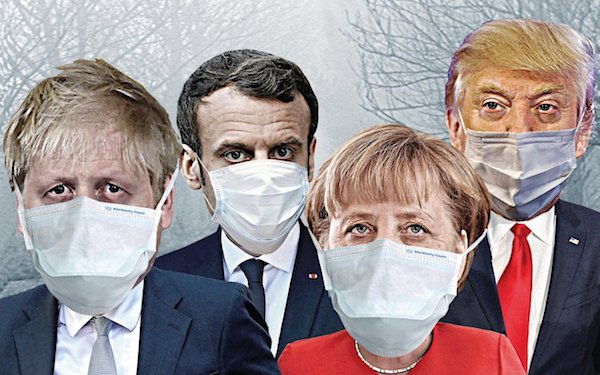
Anonymous

Lots of dry facts today, got to do it. Many people trying to do predictions, but 99% of that is nonsense based on faulty models. People need things, theories, ideas, to drive the spirits of doom from their idle heads. That’s why we need the dry facts, so we don’t get caught up in all that stuff.

• Cases 1,130,575 (+ 100,394 from yesterday’s 1,030,181)
• Deaths 60,128 (+ 5,934 from yesterday’s 54,194)

From Worldometer yesterday evening -before their day’s close-. Note: New York with over 100,000 cases would be third after Italy and Spain
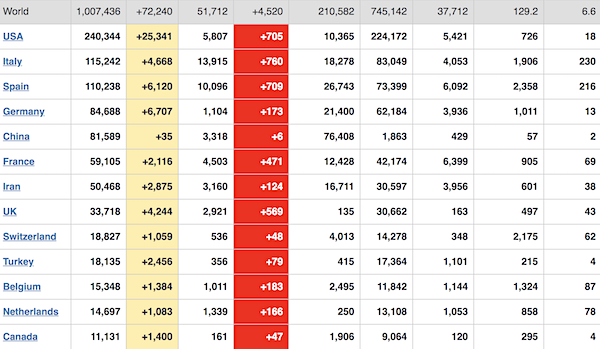
From Worldometer -NOTE: mortality rate for closed cases is at 20% –
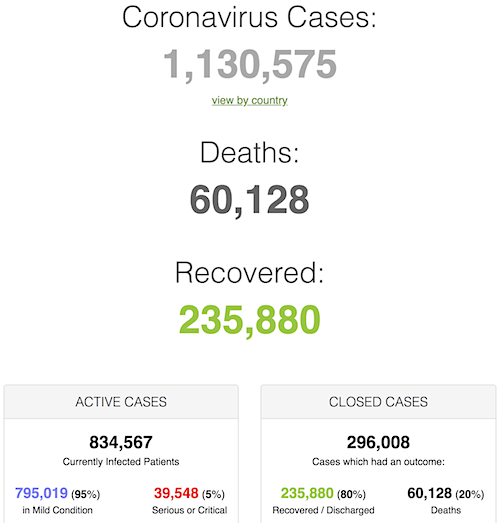
From SCMP:
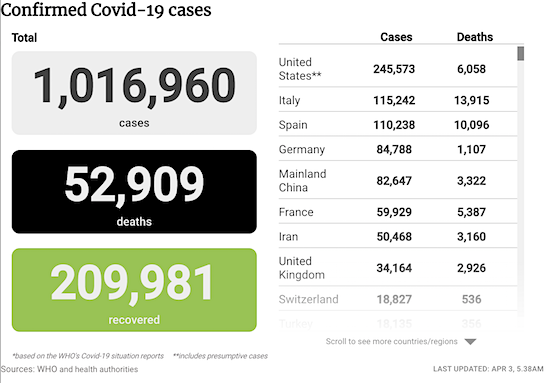
From COVID2019Info.live:
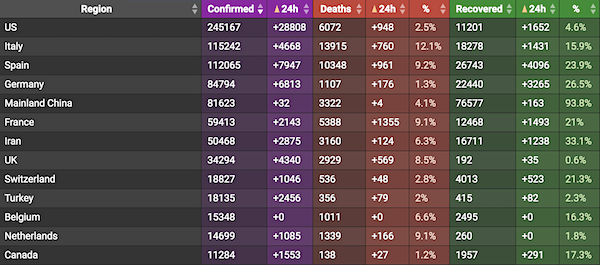

From covid19.healthdata.org: (A different set of data of projections specific for the US)

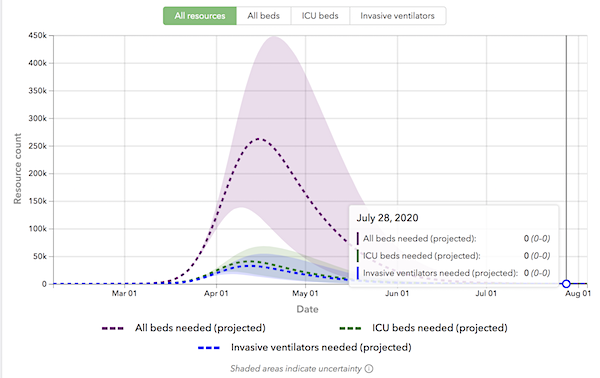
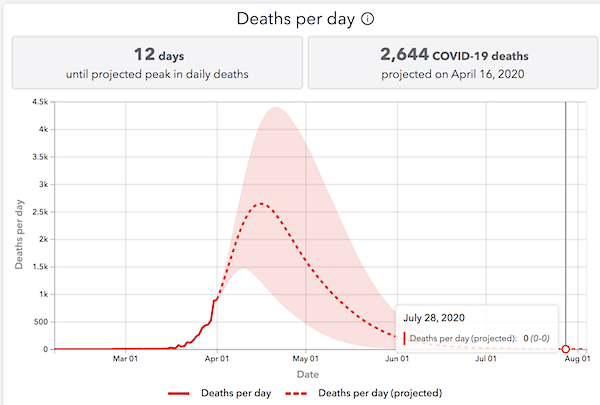

I have little patience for people who pretend they can see the future from their homes today, but I’ll always make an exception for John Gray.
• This Crisis Is A Turning Point In History (John Gray)
The deserted streets will fill again, and we will leave our screen-lit burrows blinking with relief. But the world will be different from how we imagined it in what we thought were normal times. This is not a temporary rupture in an otherwise stable equilibrium: the crisis through which we are living is a turning point in history. The era of peak globalisation is over. An economic system that relied on worldwide production and long supply chains is morphing into one that will be less interconnected. A way of life driven by unceasing mobility is shuddering to a stop. Our lives are going to be more physically constrained and more virtual than they were. A more fragmented world is coming into being that in some ways may be more resilient.
The once formidable British state is being rapidly reinvented, and on a scale not seen before. Acting with emergency powers authorised by parliament, the government has tossed economic orthodoxy to the winds. Savaged by years of imbecilic austerity, the NHS – like the armed forces, police, prisons, fire service, care workers and cleaners – has its back to the wall. But with the noble dedication of its workers, the virus will be held at bay. Our political system will survive intact. Not many countries will be so fortunate. Governments everywhere are struggling through the narrow passage between suppressing the virus and crashing the economy. Many will stumble and fall. In the view of the future to which progressive thinkers cling, the future is an embellished version of the recent past.
No doubt this helps them preserve some semblance of sanity. It also undermines what is now our most vital attribute: the ability to adapt and fashion different ways of life. The task ahead is to build economies and societies that are more durable, and more humanly habitable, than those that were exposed to the anarchy of the global market. [This] does not mean a shift to small-scale localism. Human numbers are too large for local self-sufficiency to be viable, and most of humankind is not willing to return to the small, closed communities of a more distant past. But the hyperglobalisation of the last few decades is not coming back either. The virus has exposed fatal weaknesses in the economic system that was patched up after the 2008 financial crisis. Liberal capitalism is bust.
With all its talk of freedom and choice, liberalism was in practice the experiment of dissolving traditional sources of social cohesion and political legitimacy and replacing them with the promise of rising material living standards. This experiment has now run its course. Suppressing the virus necessitates an economic shutdown that can only be temporary, but when the economy restarts, it will be in a world where governments act to curb the global market. A situation in which so many of the world’s essential medical supplies originate in China – or any other single country – will not be tolerated. Production in these and other sensitive areas will be re-shored as a matter of national security. The notion that a country such as Britain could phase out farming and depend on imports for food will be dismissed as the nonsense it always has been. The airline industry will shrink as people travel less. Harder borders are going to be an enduring feature of the global landscape. A narrow goal of economic efficiency will no longer be practicable for governments.
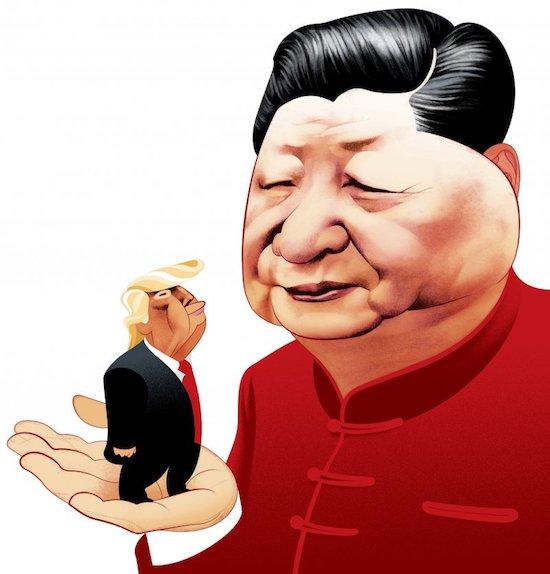

The Asian Development Bank has no more idea than your pet hamster. But they have academic titles, call themselves professionals, get paid the big bucks, and do modeling. One faulty variable in a model is enough to make it useless of course.
• Asian Development Bank Says Pandemic Could Cost $4.1 Trillion (UPI)
The Asian Development Bank said Friday that the pandemic could cost the world between $2 trillion and $4.1 trillion, equaling between 2.3 percent and 4.8 percent of global GDP. The figure is a stark increase from the $347 billion at the top end, or equivalent to 0.4 percent of global GDP, the Manila-based regional development bank predicted on March 6. The bank also revised down its growth forecast for Asia to 2.2 percent from the 5.5 percent it had predicted in September. Assuming the pandemic ends, it expects growth to rebound to 6.2 percent next year. However, ADB Chief Economist Yasuyuki Sawada admitted that these numbers could be off depending on how the world reacts to the pandemic, calling on world leaders to implement measures to lessen the virus’ impact on the markets.
“The evolution of the global pandemic – and thus the outlook for the global and regional economy – is highly uncertain,” Yasuyuki said in a statement. “Growth could turn out lower, and the recovery slower, than we are currently forecasting. For this reason, strong and coordinated efforts are needed to contain the COVID-19 pandemic and minimize its economic impact, especially on the most vulnerable.” For China specifically, the bank sees its recent contraction in industry, services, retail sales and investment to drag growth down to 2.3 percent this year though with expectations it will rebound to 7.3 percent in 2021. Excluding the industrialized economies of Hong Kong, South Korea, Singapore and Taipei, growth in developing Asia was revised down to 2.4 percent from 5.7 percent last year.

These folk have no more idea than the Asian Development Bank does. But, again, they have academic titles, call themselves professionals, get paid the big bucks, and do modeling. If they would be honest annd say we don’t have a clue, they might lose their jobs.
• The Keys To Reopening America (BI)
It’s going to take a long time for the US to recover from the ongoing coronavirus pandemic, both physically and economically. A team of experts— including former Trump Food and Drug Administration chief Scott Gottlieb — at the Washington D.C. based American Enterprise Institute (AEI), have come up with a plan to reopen the country state-by-state. AEI is a non-partisan think tank closely linked to conservative thought. The four-part plan advocates for a step-by-step approach in first slowing the spread of the disease (Phase I), gradually reopening stores, schools, public areas, and most businesses (Phase II), closely monitoring, identifying, and potentially curing new outbreaks (Phase III), and then creating and investing in a system to ensure the US’s public health infrastructure is prepared for the next pandemic or public health crisis.
As of Thursday afternoon, over 1 million people globally have been infected with the virus. The US has over 234,000 cases, roughly one-quarter of the world’s total. That number is still rising rapidly, and the federal government has extended its social distancing guidelines to April 30 at least. In order to move from Phase I to Phase II, the AEI researchers outline several milestones. They say that there needs to be a sustained reduction in cases over a 14-day period, hospitals should be able to adequately serve all patients, the state has to have the capacity to test all those reporting symptoms, and it should be able to closely monitor those with confirmed cases as well as their social contacts.
In Phase II, states should be able to carefully lift social distancing measures, allow schools and most businesses to reopen, and continue to control the spread of the coronavirus to avoid reverting back to Phase I. One of the critical signs that a state should revert is if confirmed cases increase over a five-day period, or hospitals are no longer able to care for patients due to a lack of resources. Once schools are open, the AEI experts say physical distancing restrictions should still be met, including limiting public gatherings to less than 50 people and encouraging people to maintain “hand hygiene and respiratory etiquette.” They say high-touch surfaces should be disinfected regularly and public spaces should be cleaned frequently.
Talking about “phases”:
Some Sanders demands for "phase 4" of coronavirus response:
— $2K/person payments *every month* – 100% universal;
— Medicare pays all health expenses during pandemic;
— Suspend rent/mortgage/medical/student&debt payments for 4 months;
— Hazard pay 4 frontline workers
— Jeffrey Stein (@JStein_WaPo) April 3, 2020

At least some people are being kept busy.
• At Least 8 Strains Of The Coronavirus Have Been Identified (Hill)
Researchers have identified at least eight strains of the novel coronavirus that has infected more than one million people across the globe, and say the mutations are useful in determining just how the virus is spreading. Thousands of genetic sequences of the virus have been uploaded to the open database NextStrain, which shows how the virus is migrating and splitting into new but similar subtypes. Researchers said the data show the virus is mutating on average every 15 days, according to National Geographic. NexStrain co-founder Trevor Bedford said, however, the mutations are so small that no one strain of the virus is more deadly than another. Researchers also say it does not appear the strains will grow more lethal as they evolve.
“These mutations are completely benign and useful as a puzzle piece to uncover how the virus is spreading,” Bedford told National Geographic. Bedford said the different strains make it possible for researchers to see whether community transmission is widespread in a region, which can show whether stay-at-home measures are working. “We’ll be able to tell how much less transmission we’re seeing and answer the question, ‘Can we take our foot off the gas?” Bedford said. The database also shows how the coronavirus is spreading throughout the U.S. Charles Chiu, a professor of medicine and infectious disease at the University of California, San Francisco School of Medicine, told USA Today that the outbreaks are “trackable,” and “we have the ability to do genomic sequencing almost in real-time to see what strains or lineages are circulating.”
A majority of cases on the West Coast have been linked to a strain first identified in Washington state, which is three mutations away from the first known strain, while on the East Coast, the virus seems to have come from China to Europe and then to New York, according to USA Today. Kristian Andersen, a professor at Scripps Research, told USA Today the maps only show a snapshot of the full spread of the virus. “Remember, we’re seeing a very small glimpse into the much larger pandemic,” Andersen told USA Today. “We have half a million described cases right now but maybe 1,000 genomes sequenced. So there are a lot of lineages we’re missing.”

These people appear to be busy as well.
• NY Funeral Homes Struggle As Virus Deaths Surge (AP)
Pat Marmo walked among 20 or so deceased in the basement of his Brooklyn funeral home, his protective mask pulled down so his pleas could be heard. “Every person there, they’re not a body,” he said. “They’re a father, they’re a mother, they’re a grandmother. They’re not bodies. They’re people.” Like many funeral homes in New York and around the globe, Marmo’s business is in crisis as he tries to meet surging demand amid the coronavirus pandemic that has killed around 1,400 people in New York City alone, according to a tally from Johns Hopkins University. His two cell phones and the office office line are ringing constantly. He’s apologizing to families at the start of every conversation for being unusually terse, and begging them to insist hospitals hold their dead loved ones as long as possible.
His company is equipped to handle 40 to 60 cases at a time, no problem. On Thursday morning, it was taking care of 185. “This is a state of emergency,” he said. “We need help.” Funeral directors are being squeezed on one side by inundated hospitals trying to offload bodies, and on the other by the fact that cemeteries and crematoriums are booked for a week at least, sometimes two. Marmo let AP into his Daniel J. Schaefer funeral home in the Sunset Park neighborhood of Brooklyn on Thursday to show how dire the situation has become. He has about 20 embalmed bodies stored on gurneys and stacked on shelves in the basement and another dozen in his secondary chapel room, both chilled by air conditioners.
He estimated that more than 60% had died of the new coronavirus. For most people, the virus causes mild or moderate symptoms, but for some, especially older adults and people with existing health problems, it can cause more severe illness and lead to death. “It’s surreal,” he said. Hospitals in New York have been using refrigerated trucks to store the dead, and Marmo is trying to find his own. One company quoted him a price of $6,000 per month, and others are refusing outright because they don’t want their equipment used for bodies. Even if he gets a truck, he has nowhere obvious to put it. He’s wondering if the police station across the street might let him use its driveway.
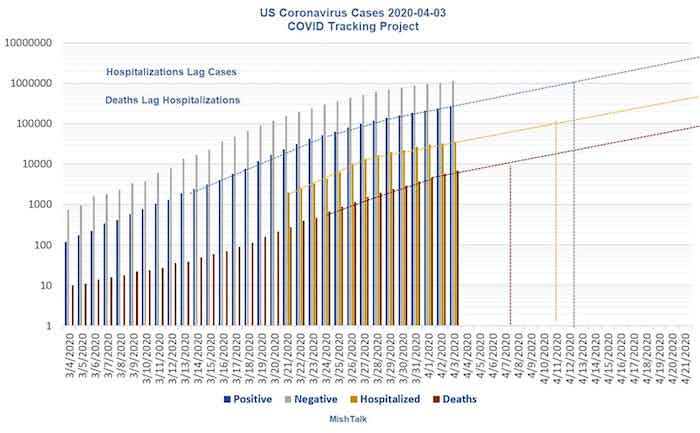
Covid Tracking Project Chart (Mish)

They will soon have to decide who to put on a ventilator and who not. This could stop entire hospitals from functioning.
• US Doctors On Coronavirus Frontline Seek Protection From Malpractice Suits (R.)
U.S. medical professionals on the front line of the coronavirus pandemic are lobbying policymakers for protection from potential malpractice lawsuits as hospitals triage care and physicians take on roles outside their specialties. State chapters of the powerful American Medical Association and other groups representing healthcare providers have been pressing governors for legal cover for decisions made in crisis-stricken emergency rooms. More than half a dozen emergency room doctors and nurses told Reuters they are concerned about liability as they anticipate rationing care or performing unfamiliar jobs due to staff and equipment shortages caused by the outbreak.
Governors in New York, New Jersey and Michigan have responded with orders that raised the standard for injuries or deaths while working in support of the state’s response to COVID-19 from negligence to gross negligence, or an egregious deviation from standard care. Physicians, who have long blamed malpractice lawsuits for driving up healthcare costs, hope other states will follow. “There are too many variables here. We are going to be second-guessed,” said Jeremy Faust, an emergency physician at Brigham and Women’s Hospital (BWH) in Boston. “We need better protection, if only to guard against unreasonable claims.”

Groucho: “Those are my principles, and if you don’t like them… well, I have others..”
• Russian Ventilators Sent To US Made By Firm Under US Sanctions (R.)
Ventilators delivered by Russia to the United States for coronavirus patients were manufactured by a Russian company that is under U.S. sanctions, Russia’s RBC business daily reported on Friday. A Russian military plane carrying the ventilators along with other medical supplies including personal protective equipment landed in New York on Wednesday after U.S. President Donald Trump and Russian President Vladimir Putin spoke by phone. Russian state television footage of the plane’s unloading showed boxes of “Aventa-M” ventilators, which are produced by the Ural Instrument Engineering Plant (UPZ) in the city of Chelyabinsk, 1,500 km (930 miles) east of Moscow, RBC reported. UPZ is part of a holding company called Concern Radio-Electronic Technologies (KRET), which itself is a unit of Russian state conglomerate Rostec.
KRET has been under U.S. sanctions since July 2014, with U.S. firms and nationals barred from doing business with it. The issue was further complicated by the question of whether it was the United States or Russia’s sovereign wealth fund RDIF, which was added to U.S. sectoral sanctions in 2015, that paid for the ventilators. A senior administration official on Friday said sanctions did not apply to medical supplies. “The United States is purchasing the supplies and equipment outright, as with deliveries from other countries. The Russian Direct Investment Fund is subject to certain debt and equity-related sectoral sanctions, which would not apply to transactions for the provision of medical equipment and supplies,” the official said.

These are the kinds of things that are bound to backfire.
• US Snatches Masks From Germany In Act Of ‘Modern Piracy’ – Berlin (RT)
With Covid-19 infections climbing, Washington has diverted shipments of vital protective masks from its allies in Germany and Canada to the US. A Berlin senator described the move as “modern piracy.” As confirmed coronavirus cases passed 250,000 in the US this week, the White House pressured safety gear manufacturer 3M to step up imports of protective masks from its Chinese factories. Trump publicly promised on Thursday that 3M would “have a big price to pay” if it didn’t increase supply to the US. But behind the scenes, American officials were acquiring these masks by more underhand means. A delivery of 200,000 masks left a 3M factory in China this week and arrived in Bangkok, Thailand, from where they were supposed to be sent to the German capital.
The masks never got to Berlin, and police in the city told Der Tagesspiegel that the shipment was instead bound for the US. Berlin’s Senator for the Interior Andreas Geisel confirmed on Friday that the masks had been “confiscated.” “We consider this an act of modern piracy. This is not how you deal with transatlantic partners,” Geisel said. Berlin police chief Barbara Slowik told Tagesspiegel that she believes 3M redirected the shipment because of the US government’s export ban. The company denied the charge, while a White House spokesman told another German newspaper that the accusation of piracy was “completely wrong.”
Yet Germany isn’t the only country to see its shipments apparently nabbed by the Americans. In Canada last week, Le Journal de Montreal reported that a shipment of masks bound for hospitals in the city was diverted to the US state of Ohio. Shipping firm DHL later attributed this to a “computer error,” but Montreal hospital supplier Fan Zhou claimed his order eventually arrived 10,000 masks short.

It really IS the Grapes of Wrath all over again.
• US Dairy Farmers Dump Milk As Pandemic Upends Food Markets (R.)
Dairy farmer Jason Leedle felt his stomach churn when he got the call on Tuesday evening. “We need you to start dumping your milk,” said his contact from Dairy Farmers of America (DFA), the largest U.S. dairy cooperative. Despite strong demand for basic foods like dairy products amid the coronavirus pandemic, the milk supply chain has seen a host of disruptions that are preventing dairy farmers from getting their products to market. Mass closures of restaurants and schools have forced a sudden shift from those wholesale food-service markets to retail grocery stores, creating logistical and packaging nightmares for plants processing milk, butter and cheese. Trucking companies that haul dairy products are scrambling to get enough drivers as some who fear the virus have stopped working.
And sales to major dairy export markets have dried up as the food-service sector largely shuts down globally. The dairy industry’s woes signal broader problems in the global food supply chain, according to farmers, agricultural economists and food distributors. The dairy business got hit harder and earlier than other agricultural commodities because the products are highly perishable – milk can’t be frozen, like meat, or stuck in a silo, like grain. Other food sectors, however, are also seeing disruptions worldwide as travel restrictions are limiting the workforce needed to plant, harvest and distribute fruits and vegetables, and a shortage of refrigerated containers and truck drivers have slowed the shipment of staples such as meat and grains in some places.

As long as Assange keeps being locked up in maximum security, the US doesn’t care one bit.
• US AG Barr Orders Release Of More Federal Inmates (R.)
U.S. Attorney General William Barr declared on Friday that the federal Bureau of Prisons (BOP) is facing emergency conditions due to the fast-spreading coronavirus, paving the way for the agency to begin releasing more inmates out of custody and into home confinement. Barr said under his emergency order, priority for releasing vulnerable inmates into home confinement should be given first to those housed in federal prisons that have been hardest hit by COVID-19, including facilities such as Oakdale in Louisiana, Elkton in Ohio and Danbury in Connecticut. Barr’s order comes after five inmates at FCI Oakdale 1 and two at FCI Elkton 1 died from COVID-19, the respiratory illness caused by the novel coronavirus.
The BOP said Friday that 91 inmates and 50 of its staff throughout its 122 institutions have fallen ill with COVID-19. Union officials and families of prisoners have told Reuters they believe the number of people sickened with the virus is much higher. Earlier this week, the BOP took the unprecedented step of ordering all of its facilities to place inmates into a 14-day quarantine by confining them to their cells or living quarters. The $2 trillion stimulus bill signed by President Donald Trump last week included a provision designed to make it easier for federal prisons to release more inmates into home confinement to help control the coronavirus outbreak. Prior to the stimulus law, the BOP could release to home confinement only inmates who had already served at least 90% of their sentence or had no more than six months left to go.
The new law allows the BOP director greater discretion to release a larger cohort of inmates. But it required that Barr first declare a state of emergency for the federal prison system. “For all inmates whom you deem suitable candidates for home confinement, you are directed to immediately process them for transfer and then immediately transfer them following a 14-day quarantine,” Barr directed the BOP in a memo released late Friday.

Why not send them to jail, so Bill Barr can release tham?
• Ankle Monitors Ordered For Kentucky Residents Refusing Quarantine (Hill)
Despite Governor Andy Beshear ordering all Kentucky residents to stay at home to mitigate the spread of the coronavirus, some in Louisville are reportedly refusing to self-quarantine. As a response, Jefferson Circuit Court judge Angela Bisig is ordering ankle monitors for those who were exposed to the coronavirus but who won’t stay at home. CNN reports that Bisig ordered an individual identified as D.L. to wear a global positioning device for the next two weeks. D.L is reportedly living with someone who tested positive for the coronavirus, as well as someone who is a presumptive case. About a week ago, D.L. was ordered to self-quarantine for 14 days, the amount of time it takes for an infected individual to exhibit symptoms of the coronavirus.
Family members, however, said he leaves his home often. Bisig ordered the state’s Department of Corrections to place an ankle monitor on D.L., who will face criminal charges if they leave the house again. CNN cites local outlet WDRB as reporting that other Louisville residents were ordered to don ankle monitors as well after they refused to self-isolate. These individuals were also reported as either having the coronavirus or being in contact with the coronavirus. WDRB reports that Jefferson County has a judge on-call for these types of cases. This concerning report comes after a group of young Kentucky residents reportedly threw a “coronavirus party” that resulted in at least one person catching the virus.

Poetic justice. $3 billion in cash reserves for a company that lost $320 in the first 9 months of 2019.
• The COVID19 Crisis Locked Airbnb Out Of Its Own Homes (G.)
Airbnb’s army of 700,000 hosts are distraught at the income they are losing as a result of the company’s generosity to guests. Chesky this week apologised and said the company would spend $250m (£200m) covering 25% of what hosts would have been paid for reservations between 14 March and 31 May. An additional $10m relief fund is being made available to “super hosts” offering grants of up to $5,000 for “hosts who hurt the most”. Airbnb founders will also take no salary for six months, and top executives will have their salaries halved. “Although it may not have felt like it, we are partners,” Chesky said in email to hosts. “When your business suffers, our business suffers. We know that right now many of you are struggling, and what you need are actions from us to help, not just words.”
Airbnb has built up reported cash reserves of $3bn from booking fees charged to both guests and hosts. It collected revenues from the fees in excess of $4.8bn last year, according to Reuters. Hosts are charged 3% of every booking, while guests are charged up to 14.2%. The hangover from the coronavirus pandemic is likely to last far longer than 31 May or whenever governments lift movement restrictions. Hosts report empty booking calendars stretching throughout the summer, and research by analysis website AirDNA shows bookings in some cities has fallen by as much as 96%. For hosts who occasionally rent out their spare room in the style of a real bed & breakfast the lost Airbnb income due the coronavirus is a frustration.
But, for those who have built up mini (or in some cases not-so-mini) property portfolios that rely on a constant stream of guests churning through Airbnb apartments in Bath, Barcelona or Berlin, the prospect of weeks or months without guests spells financial disaster. It is also a disaster for Chesky, 38, and the large number of Airbnb’s employees who hold stock options. The company was lining up for a stock market flotation this year, which some investors hoped would value the 11-year-old tech giant at up to $42bn – even though the Wall Street Journal reported the business lost nearly $320m in just the first nine months of last year. In a video presentation on Thursday, Chesky told staff the company had lowered its valuation to $26bn, down from $31bn when it last raised money from investors in September 2017, according to the Financial Times.
[..] “They are stuffed, the IPO just can’t happen,” Richard Holway, chairman of analyst firm TechMarketView, said. “Airbnb is in the worst of the worst situations. Unlike other tech firms, like Uber which can do deliveries instead of driving people, it can’t diversify. There’s nothing Airbnb can do to make money. “Everything indicates that Airbnb income around the world has just stopped,” he said. “It [coronavirus and lockdown] has exposed the Airbnb business model, and it’s going to pull thousands and thousands of people down with it. People [hosts] have gone into it as an absolute business and they’re in a very, very difficult situation.”

The anonymous whistleblower strikes again. And Schiff seeks some exposure, yelling: hey, I’m still here, where are the cameras?
• Trump Firing Inspector General Who Flagged Whistleblower Complaint (NBC)
President Donald Trump has informed Congress that he is removing the inspector general who flagged the Ukraine whistleblower complaint, according to a letter obtained by NBC News. “This is to advise that I am exercising my power as President to remove from office the Inspector General of the Intelligence Community,” the Trump letter to the leaders of the House and Senate intelligence committees says. The letter also says “it is vital that I have the fullest confidence in the appointees serving as Inspectors General. That is no longer the case with regard to this Inspector General.” The firing is to take effect 30 days from Friday, according to the letter. News of the complaint and the fact it had been withheld from Congress touched off an inquiry and testimony that resulted in Trump’s impeachment. Trump was acquitted by the Senate.
Michael Atkinson deemed the complaint an “urgent concern” that he was required by law to provide to the congressional intelligence committees. But then-Acting Director of National Intelligence Joseph Maguirerefused to do so on the advice of the Justice Department, resulting in a standoff. Two Congressional sources told NBC News Atkinson was informed Friday night that Trump had fired him, and he has been placed on administrative leave effective immediately. The statute technically requires that both intelligence committees be notified by Trump 30 days before the effective date of the IG’s removal, and placing him on administrative leave is being viewed by Congress as a way to effectively circumvent this requirement and sideline him right away.
Rep. Adam Schiff, D-Calif., who chairs the House Intelligence Committee and who played a key role in the impeachment of Trump, called the president’s move an attempt to “retaliate against those who dare to expose presidential wrongdoing.” “At a time when our country is dealing with a national emergency and needs people in the Intelligence Community to speak truth to power, the President’s dead of night decision puts our country and national security at even greater risk,” Schiff said, referring to the coronavirus epidemic. “Moreover, this retribution against a distinguished public servant for doing his job and informing Congress of an urgent and credible whistleblower complaint is a direct affront to the entire inspector general system,” Schiff said in the statement. “It undermines the transparency and oversight the American people expect of their government, and in its absence will undoubtedly lead to even greater corruption in the Administration.”

You think Schiff was thinking he’d get the job?
• Trump Names White House Lawyer As Watchdog Over Coronavirus Bailout (Solomon)
President Trump on Friday named a White House lawyer to be the chief watchdog to oversee the spending of $2 trillion in coronavirus stimulus money. Brian D. Miller, a special assistant to the president and a senior associate White House counsel, will serve as Special Inspector General for Pandemic Recovery inside the Treasury Department. Miller served as the Senate-confirmed Inspector General for the General Services Administration for nearly a decade, where he led more than 300 auditors, special agents, attorneys, and support staff in conducting nationwide audits and investigations. As the GSA IG, Miller reported on fraud, waste, and abuse, including lavish spending on employee conference trips to Las Vegas. Previously he served inside the Justice Department as a lawyer for the deputy attorney general and as a federal prosecutor in Virginia.

More info the FBI held back.
• Translator Exonerated Don Jr. In Trump Tower Meeting (Solomon)
In Robert Mueller’s final report on the Russia investigation, a little-known translator named Anatoli Samochornov played a bit role, a witness sparsely quoted about the infamous Trump Tower meeting he attended in summer 2016 between Donald Trump Jr. and a mysterious Russian lawyer. The most scintillating information Mueller’s team ascribed to Samochornov in the report was a tidbit suggesting a hint of impropriety: The translator admitted he was offered $90,000 by the Russians to pay his legal bills, if he supported the story of Moscow attorney Natalia Veselnitskya. He declined. But recently released FBI memos show that Samochornov, a translator trusted by the State Department and other federal agencies, provided agents far more information than was quoted by Mueller, nearly all of it exculpatory to the president’s campaign and his eldest son.
Despite learning the translator’s information on July 12, 2017, just a few days after the media reported on the Trump Tower meeting, the FBI would eventually suggest Donald Trump Jr. was lying and that the event could be seminal to Russian election collusion. Samochornov’s eyewitness account entirely debunks the media’s narrative, the FBI memos show. “Samochornov was not particularly fond of Donald Trump Jr., but stated Donald Trump Jr.’s account with Veselnitskya as portrayed in recent media report, was accurate,” according to the FBI 302 report on its interview of the translator. “Samachornov concurred with Donald Trump Jr.’s accounts of the meeting. He added ‘they’ were telling the truth.” So what was that truth, and how did it compare to the media version of events that took root in summer 2017?
The media narrative at the time was that the meeting might be a key piece of evidence of collusion between the Trump campaign and Russia: Trump Jr., brother-in-law Jared Kushner, and then-Trump campaign chairman Paul Manafort were all lured to a meeting by the Russian lawyer Veselnitskya supposedly to talk about Russian dirt on Hillary Clinton. Trump Jr.’s account, ridiculed by the media and Democrats at the time, was that the short meeting ended up being about a Russian lobbying campaign to change adoption practices under a U.S. human rights law that punished Moscow and other foreign bad actors known as the Magnitsky Act.

Funny how the reports come out just as Monsanto is preparing to save American farmers.
• Monsanto Predicted Crop System Would Damage US Farms (G.)
The US agriculture giant Monsanto and the German chemical giant BASF were aware for years that their plan to introduce a new agricultural seed and chemical system would probably lead to damage on many US farms, internal documents seen by the Guardian show. Risks were downplayed even while they planned how to profit off farmers who would buy Monsanto’s new seeds just to avoid damage, according to documents unearthed during a recent successful $265m lawsuit brought against both firms by a Missouri farmer. The documents, some of which date back more than a decade, also reveal how Monsanto opposed some third-party product testing in order to curtail the generation of data that might have worried regulators.
And in some of the internal emails, employees appear to joke about sharing “voodoo science” and hoping to stay “out of jail”. The new crop system developed by Monsanto and BASF was designed to address the fact that millions of acres of US farmland have become overrun with weeds resistant to Monsanto’s glyphosate-based weedkillers, best known as Roundup. The collaboration between the two companies was built around a different herbicide called dicamba. [..] The companies announced in 2011 that they were collaborating in the development of the dicamba-tolerant cropping systems, granting each other reciprocal licenses, with BASF agreeing to supply formulated dicamba herbicide products to Monsanto.
The companies said they would make new dicamba formulations that would stay where they were sprayed and would not volatilize as older versions of dicamba were believed to do. With good training, special nozzles, buffer zones and other “stewardship” practices, the companies assured regulators and farmers that the new system would bring “really good farmer-friendly formulations to the marketplace”. But in private meetings dating back to 2009, records show agricultural experts warned that the plan to develop a dicamba-tolerant system could have catastrophic consequences. The experts told Monsanto that farmers were likely to spray old volatile versions of dicamba on the new dicamba-tolerant crops and even new versions were still likely to be volatile enough to move away from the special cotton and soybean fields on to crops growing on other farms.

Sue them into oblivion.
• Monsanto & BASF Knew For Years Their Products Destroy US Farms (RT)
US agro-chemical firm Monsanto and Germany’s BASF were aware for a long time that their plan to introduce a new agricultural seed and chemical system would probably lead to damage on many US farms. According to internal documents seen by the Guardian, the firms disregarded the risks even while they planned on how to profit off farmers who would buy Monsanto’s new seeds just to avoid damage. The documents (some of them date back more than a decade) have been uncovered during a recent successful $265 million lawsuit brought against both firms by a Missouri farmer. They also revealed how Monsanto opposed some third-party product testing, in order to curtail the generation of data that might have worried regulators.
In some of the internal BASF emails, employees were joking about sharing “voodoo science” and hoping to stay “out of jail.” Records showed that at private meetings dating back to 2009, agricultural experts warned that the plan to develop a dicamba-tolerant system could have catastrophic consequences. [..] The experts told Monsanto that farmers were likely to spray old volatile versions of dicamba on the new dicamba-tolerant crops. They have warned that even new versions were still likely to be volatile enough to move away from the special cotton and soybean fields on to crops growing on other farms. What is more important, under the system designed by Monsanto and BASF, only farmers buying Monsanto’s dicamba-tolerant cotton and soybean seeds would be protected from dicamba drift damage.
[..] According to a report prepared for Monsanto in 2009 as part of industry consultation, such “off-target movement” was expected, along with “crop loss”, “lawsuits” and “negative press around pesticides.” Monsanto’s own projections estimated that dicamba damage claims from farmers would total more than 10,000 cases, including 1,305 in 2016, 2,765 in 2017 and 3,259 in 2018. Both Monsanto and BASF defended their products, claiming dicamba is safe “when used correctly,” and an important tool for farmers. Industry estimates suggest that several million acres of crops have now been reported damaged by dicamba. More than 100 US farmers are engaged in litigation in federal court alleging Monsanto and BASF collaboration created a “defective” crop system that has damaged orchards, gardens and organic and non-organic farm fields in multiple states.

It must be possible to run the Automatic Earth on people’s kind donations. These are no longer the times when ads pay for all you read, your donations have become an integral part of it. It has become a two-way street; and isn’t that liberating, when you think about it?
Thanks everyone for your wonderfully generous donations over the past days.

https://twitter.com/fakerapper/status/1246177574398689280



Support us in virustime. Help the Automatic Earth survive. It’s good for you.


